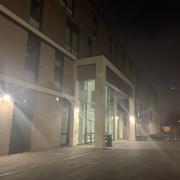
A good while ago, in sun-soaked fields on the edge of Madrid, a crumbling old house that hadn’t been touched in half a century had itself a visitor. This house had belonged to Francisco Goya, who had been the most famous and important artist in Spain, and he had left a legacy of
fourteen miserable murals - wretched scenes of death and violence and ghoulish old men and women – and very mysterious, because they’d been given no titles (the ones they have now are from art historians,) no explanation, and absolutely no one had heard anything about them, or had had any idea that they were even there. These fourteen lonely paintings had just sat there for fifty years facing the opposite wall. Because Goya was so important though they were cut from the walls and by 1878 they found themselves to be in the Prado museum in Madrid, (where they now most likely have very interesting walls, full of art, to busy themselves with,) and then they ended up being called ‘The Black Paintings’ (and they are far more exciting than the name suggests.)
My favourite one, and it’s my favourite because I think it’s the best one, is called Saturn devouring his son. It is almost certainly based on Roman mythology: the Titan, Saturn, was told by a prophet that one of his sons (it turned out to be Zeus) would grow up and overthrow him, and he was so put off by this that he ate them. (When I wrote this I said to my mum, ‘are you sure I shouldn’t say: his children would live to be his downfall?’ She said no, lots of parents think that.) Of all of Goya’s work, I think this one is the most expressive, has the loosest brushwork, and it creates an unhinged impression similar to the work of Francis Bacon. (Francis Bacon was a 20th century painter famous for the violence and brutality of his paintings.) Then comparing Goya’s depiction to one of the same story from two hundred years earlier by an artist called Peter Paul Rubens (this one is also in the Prado museum) there are several interesting differences. Rubens’ ‘son’ is a plump little baby with soft fleshy skin. When you look at his angelic face, and how pink and vulnerable he is, the tearing of his flesh feels as sharp a sting as if it were ours bitten off, whereas Goya’s ‘son’ is already a fully formed person, and already a corpse; his head is completely gone; we feel nothing for him; our sympathies lie instead with Saturn, who is crouched shamefully in the dark (unlike Rubens’ Saturn, an evil-looking man with a face full of cold, cruel hatred) and here’s the most interesting thing: Goya’s Saturn’s eyes show us fear. He’s afraid. So what’s he afraid of? His son, who he knows will ruin him? Or is he fearful of himself and his own monstrosity?
There is some disagreement as to what Goya meant by his Black Paintings. Some historians even question the idea that they have intent behind them at all, citing Goya’s state of mind at the time of their creation. Manuela Mena, who is the Goya specialist at the Prado Museum, who ‘knows him as well as anyone now living’ doesn’t agree with this interpretation: “all you hear about these pictures is how he was crazy, melancholic, pessimistic when he made them. But he was actually an optimist with a great sense of humour, very rational and very clear in his mind, right to the end of his life.” But the Black Paintings have a reputation for their feverish intensity, and their ability to haunt everyone who sees them. So what’s it about them that does it?
First, the mystery. We will never quite understand what they say; we could only know from Goya himself, who told not one soul about them. Finding such foreboding paintings left behind like a ghost sends our imagination off in a myriad of directions. Secondly, their being on the walls of his home, which there is something primitive about, I think, when you consider cave men who carefully pressed dust into the walls of their caves to form the shapes of cows, or the tendency of young children to grab their mother’s lipstick and smudge it all over their parents’ expensive wallpaper. The walls, which form the house, put the paintings in the context of the very familiar and personal surrounding of a home environment, to the extent that when we peer into Goya’s living room (or into the Prado museum) to see these paintings it’s like peering into Goya’ own soul. Then, finally, this: Goya painted the Black paintings in isolation exiled and forgotten, remember - he had no audience. This makes them very different from his previous work, and anything he could’ve come across in his lifetime, because before the 20th century painting was for looking at: in fancy houses, to impress guests, the backdrop of elaborate parties, or as frescoes in palaces or churches. Because of this, because we know the Black Paintings existed for no one other than Goya and the opposite wall, for whom there was no need for finery or for flattery, they become scenes of ruthless honesty. When you add to this what you know of Goya, the best painter in Spain, who spent his life getting human behaviour onto a canvas, and seeing the worst of it in the selfish rulers and in the horrors the Spanish citizens were sentenced to because of them – when you know all this, the Ghost of Francisco Goya becomes uncomfortably revealing, as though the skin of humanity has been peeled away for us to see its guts and bones.
So what is it that we can learn from the first modern artist about human expression in isolation? It’s this: that time in isolation gives us the unique opportunity to be entirely frank with ourselves. At home and like Goya in the middle of all kinds of commotion, we should remember not only the significance of art as a communicative tool, as Goya frequently used it, but also how its significance can be enhanced by the ability to be honest, and consequentially enables us to be truly expressive and personal. Art is the best emotional outlet we have, and it's never been more necessary that we make the most of it, now that London's creative arts are in decline. But artist Lynda Culham is optimistic about the resilience of our art and artists: 'Creativity causes creative thinkers, and what is needed during this time is creative ways around the obstacles caused by lockdown. The arts have always pulled through, from when theatres were closed in the Plague, to now.' When there's a will there's a way.


























